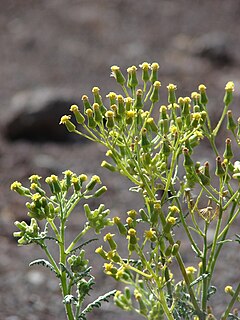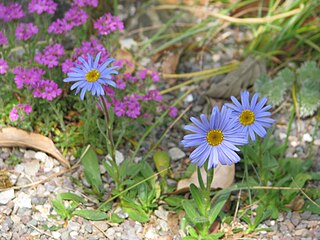
Scolymus is a genus of annual, biennial or perennial, herbaceous plants that is assigned to the family Asteraceae, and can be found in Macaronesia, around the Mediterranean, and in the Middle East. All species are spiny, thistle-like in appearance, with flowerheads that consist of yellow ligulate florets, and canals that contain latex. It is known as سكوليمس (skwlyms) in Arab, scolyme in French, and is sometimes called golden thistle or oyster thistle in English.

Scolymus maculatus is a spiny annual plant in the family Asteraceae, native to the Mediterranean region in southern Europe, southwest Asia, and northern Africa, and also the Canary Islands. It has pinnately incised prickly leaves and prickly wings along the stems, both with a white marginal vein. The yellow flowerheads stand solitary or with a few together at the tip to the stems, and subtended by more than five leaflike bracts. The plant is known as scolyme taché in French, cardogna macchiata in Italian, cardo borriquero in Spanish, and escólimo-malhado in Portuguese, חוח עקוד in Hebrew and سنارية حولية in Arabic. In English it is called spotted golden thistle or spotted oyster thistle.
Lagophylla glandulosa is a species of flowering plant in the family Asteraceae known by the common name glandular hareleaf. It is endemic to California, where it grows in the Central Valley and foothills in chaparral, grassland and woodland habitat. This is an annual herb growing a very thin stem covered in glandular hairs, especially at the top in the inflorescence. The leaves are mostly small, smooth-edged, and glandular-hairy on the top of the stem, with much larger, toothed leaves toward the base. The inflorescence bears flower heads with five bright yellow ray florets, each with three lobes. The center of the head contains six disc florets which are yellow with black anthers. The fruit is a dark brown achene with no pappus.
Lasthenia chrysantha is a species of flowering plant in the family Asteraceae known by the common name alkalisink goldfields. It is endemic to the California Central Valley, where it grows in vernal pools and alkali flats.
Arnica spathulata is a rare North American species of flowering plant in the family Asteraceae, known by the common name Klamath arnica. It is native to the Klamath Mountains of northwestern California and southwestern Oregon. It grows in woodland habitat, almost exclusively on serpentine soils.

Holocarpha heermannii is a species of flowering plant in the family Asteraceae known by the common name Heermann's tarweed. It is endemic to California.

Phaneroglossa is a genus of plants that is assigned to the daisy family. It consists of only one species, Phaneroglossa bolusii, a perennial plant of up to 40 cm high, that has leathery, line- to lance-shaped, seated leaves with mostly few shallow teeth and flower heads set individually on top of long stalks. The flower head has an involucre of just one whorl of bracts, few elliptic, white or cream ray florets, and many yellow disc florets. It is an endemic species of the Western Cape province of South Africa. Flowering mainly occurs from November to January.

Madia exigua is a species of flowering plant in the family Asteraceae known by the common names small tarweed and threadstem madia.

Madia glomerata is a species of flowering plant in the family Asteraceae known by the common name mountain tarweed.
Warionia is a genus in the tribe Cichorieae within the family Asteraceae. The only known species is Warionia saharae, an endemic of Algeria and Morocco, and it is locally known in the Berber language as afessas, abessas or tazart n-îfiss. It is an aromatic, thistle-like shrub of ½–2 m high, that contains a white latex, and has fleshy, pinnately divided, wavy leaves. It is not thorny or prickly. The aggregate flower heads contain yellow disk florets. It flowers from April till June. Because Warionia is deviant in many respects from any other Asteraceae, different scholars have placed it hesitantly in the Cardueae, Gundelieae, Mutisieae, but now genetic analysis positions it as the sister group to all other Cichorieae.

Sanvitalia abertii is a species of flowering plant in the family Asteraceae known by the common names Abert's creeping zinnia and Abert's sanvitalia. It is native to the southwestern United States and northern Mexico, where it grows in desert scrub, desert mountains and woodlands. It is an annual herb somewhat variable in appearance. The mainly erect stem may be 2 to 29 centimeters tall, and simple or with many branches. The linear or lance-shaped leaves are a few centimeters long. The plant is coated in rough hairs. The inflorescence is a cyme of flower heads with thick, leathery yellow ray florets 2 or 3 millimeters long and notched at the tips. The fruit is an achene. Achenes arising from the ray florets are light-colored and tipped with pappi, while those from the disc florets at the center of the flower head are darker and lack pappi.

Senecio hydrophiloides is a species of flowering plant in the aster family known by the common names tall groundsel and sweet marsh ragwort. It is native to western North America from British Columbia and Alberta to northern California to Utah, where it grows in wet meadows and similar habitat. It is a biennial or perennial herb producing a single erect stem or a cluster of a few stems which may exceed one meter in maximum height. The plants are green to red in color and usually without hairs, but new growth can be woolly. The leaves are lance-shaped to oval with toothed edges, the blades up to 25 centimeters long and borne on long winged petioles. The leaves are firm and sometimes a bit fleshy. The inflorescence is a loose or dense cluster of up to 30 or more flower heads lined with black-tipped phyllaries. They contain many yellowish disc florets at the center and often have some yellow ray florets, though these are sometimes absent. Senecio Hydrophiloides can cause Dermatitis.

Senecio sylvaticus is a species of flowering plant in the aster family. It is variously known as the woodland ragwort, heath groundsel, or mountain common groundsel. It is native to Eurasia, and it can be found in other places, including western and eastern sections of North America, as an introduced species and an occasional roadside weed. It grows best in cool, wet areas. It is an annual herb producing a single erect stem up to 80 centimeters tall from a taproot. It is coated in short, curly hairs. The toothed, deeply lobed leaves are up to 12 centimeters long and borne on petioles. They are evenly distributed along the stem. The inflorescence is a wide, spreading array of many flower heads, each lined with green- or black-tipped phyllaries. The heads contain yellow disc florets and most have very tiny yellow ray florets as well.

Scolymus grandiflorus is a spiny annual or biennial plant in the family Asteraceae, native to the Mediterranean region. With up to 75 cm high stems, it is the smallest of the species of Scolymus. Its stems are lined with uninterrupted spiny wings. It also has the largest flowerheads in the genus, of approximately 5 cm wide. It has yellow, sometimes yolk-yellow ligulate florets. Its vernacular name in Maltese is xewk isfar kbir, meaning "large yellow fin", cardogna maggiore in Italian, scoddi on Sicily, and scolyme à grandes fleurs in French.
Catananche lutea, is a woolly annual plant, in the family Asteraceae, with most leaves in a basal rosette, and some smaller leaves on the stems at the base of the branches. Seated horizontal flowerheads develop early on under the rosette leaves. Later, not or sparingly branching erect stems grow to 8–40 cm high, carrying solitary flowerheads at their tips with a papery involucre whitish to beige, reaching beyond the yellow ligulate florets. Flowers are present between April and June. This plant is unique for the five different types of seed it develops, few larger seeds from the basal flowerheads, which remain in the soil, and smaller seeds from the flowerheads above ground that may be spread by the wind or remain in the flowerhead when it breaks from the dead plant. This phenomenon is known as amphicarpy. The seeds germinate immediately, but in one type, germination is postponed. It naturally occurs around the Mediterranean. Sources in English sometimes refer to this species as yellow succory.

Felicia echinata, commonly known as the dune daisy or prickly felicia, is a species of shrub native to South Africa belonging to the daisy family. It grows to 1 m (3.3 ft) high and bears blue-purple flower heads with yellow central discs. In the wild, it flowers April to October.

Felicia rosulata is a hairy, perennial, herbaceous plant of up to 30 cm (1 ft) high, that is assigned to the family Asteraceae. It has a rosette of elliptic 8 cm × 2 cm leaves with 3–5 veins, and long, hairy stalks, each topped with one floral head consisting of about thirty middle blue ray florets encircling many yellow disc florets. It can be found in the mountains of Lesotho, eastern South Africa and Eswatini.

Felicia nordenstamii is a flowering shrub in the family Asteraceae. It is found only in South Africa where it grows on limestone hills close to the sea on the southern coast. Felicia nordenstamii is a many-branched shrub growing up to 30 cm (1 ft) tall. The lower parts of the stems are covered in grayish brown bark and the upper stem has many crowded, upwardly angled, alternate leaves with long hairs on the lower surfaces. Large flower heads form at the tips of the branches, each about 41⁄2 cm across, with about thirty purplish blue ray florets surrounding many yellow disc florets.
Felicia westae is a sparsely branched shrub growing up to 40 cm tall, that is assigned to the family Asteraceae. The lower parts of the stems have lost their leaves and the upper part has many crowded, upwardly angled and curved, alternate leaves pressed against the stem, with the edges curled inward. The flower heads form at the tips of the branches, each about 31⁄3 cm across, with about twenty purplish blue ray florets surrounding many yellow disc florets. It is only known from a small area in the Eastern Cape province of South Africa.

Felicia is a genus of small shrubs, perennial or annual herbaceous plants, with 85 known species, that is assigned to the daisy family. Like in almost all Asteraceae, the individual flowers are 5-merous, small and clustered in typical heads, and which are surrounded by an involucre of, in this case between two and four whorls of, bracts. In Felicia, the centre of the head is taken by yellow, seldom whitish or blackish blue disc florets, and is almost always surrounded by one single whorl of mostly purple, sometimes blue, pink, white or yellow ligulate florets and rarely ligulate florets are absent. These florets sit on a common base and are not individually subtended by a bract. Most species occur in the Cape Floristic Region, which is most probably the area where the genus originates and had most of its development. Some species can be found in the eastern half of Africa up to Sudan and the south-western Arabian peninsula, while on the west coast species can be found from the Cape to Angola and one species having outposts on the Cameroon-Nigeria border and central Nigeria. Some species of Felicia are cultivated as ornamentals and several hybrids have been developed for that purpose.














